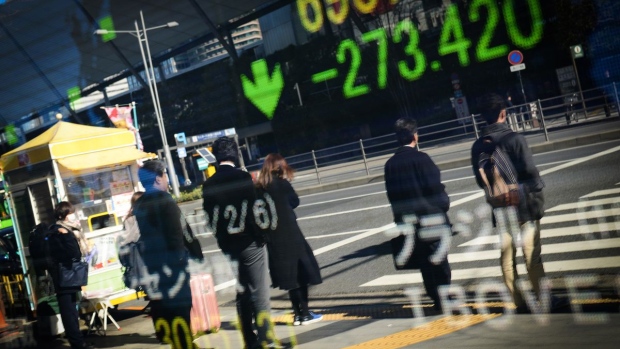Dec 14, 2018
North American stocks slip on global growth concerns
, Bloomberg News

U.S. stocks closed at their lowest level since April, with Treasuries rising alongside the yen, as mounting concern over the health of the global economy overshadowed positive trade developments and signs of strength from the American consumer.
The S&P 500 Index tumbled 1.9 per cent Friday, after testing February lows, erasing the week’s gains. Health-care and technology stocks were among the biggest decliners. The Dow Jones Industrial Average sank almost 500 points, led by Johnson & Johnson’s biggest rout in years amid mounting legal peril. Retailers retreated even after monthly data indicated U.S. consumers are still spending. Oil and gold fell.
In Canada, the TSX/S&P Composite Index closed down 1.05 per cent, losing 155.28 points to end the week at 14,595.07.
The sour mood on Wall Street came after equities slumped from Asia to Europe on concern that Chinese growth is slowing. President Donald Trump attributed the latest data to his trade war, even suggesting a deal could come soon. Investors took little solace in that, and earlier signs that trade tension was easing didn’t do much to calm nerves.
“People see the challenges into 2019, and it’s the same litany of fundamental challenges with revenue growth, global growth, all of these questions,” said Yousef Abbasi, director of U.S. institutional equities and global market strategist at INTL FCStone. “They want to see something positive, but at the same time, they’re hesitant to react when it’s a small positive. It almost seems like they want the whole kit and caboodle.”
Lackluster data also sent the euro down, as France’s “Yellow Vests” movement exacerbated a decline in the region’s PMI data to the lowest in more than four years. The pound slid after European leaders rebuffed Prime Minister Theresa May’s pleas to help her sell her Brexit agreement to a skeptical British parliament.
Growth concerns came back into focus midweek after European Central Bank President Mario Draghi said economic risks were moving to the downside, while in China retail sales and industrial production figures for November fell significantly short of estimates. The weak readings from Europe on car sales and manufacturing simply added to the gloom.
Here are some key events for investors in the days ahead:
The Federal Reserve holds its final policy meeting of 2018 on Tuesday and Wednesday. The rate decision will be followed by a press conference with Chairman Jerome Powell. A partial U.S. government shutdown could start next week if lawmakers and President Trump fail to resolve how much money to allocate for Trump’s wall along the Mexican border.
And these are the main moves in markets:
Stocks
The S&P 500 Index fell 1.9 per cent as of 4 p.m. New York time, the biggest drop in a week. The Stoxx Europe 600 Index dipped 0.6 per cent. The U.K.’s FTSE 100 Index decreased 0.5 per cent. Germany’s DAX Index fell 0.5 per cent. The MSCI Emerging Markets Index gained 0.7 per cent.
Currencies
The Bloomberg Dollar Spot Index jumped 0.3 per cent to the highest in over a month. The euro sank 0.5 per cent to US$1.1303. The British pound dipped 0.5 per cent to US$1.2582. The Japanese yen rose 0.2 per cent to 113.39 per U.S. dollar, its biggest climb in over a week.
Bonds
The yield on 10-year Treasuries dipped two basis points to 2.89 per cent, the first retreat in a week. Germany’s 10-year yield declined three basis points to 0.25 per cent, the biggest decrease in more than a week. Britain’s 10-year yield declined five basis points to 1.24 per cent.
Commodities
West Texas Intermediate crude decreased 2.8 per cent to US$51.09 a barrel. Gold decreased 0.3 per cent to US$1,238.42 an ounce.